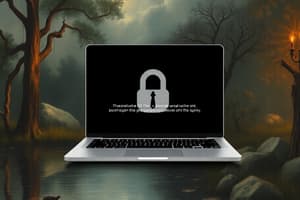Podcast
Questions and Answers
What is the primary purpose of ransomware?
What is the primary purpose of ransomware?
- To monitor online activity
- To deny access to files by encrypting them (correct)
- To provide free software updates
- To improve system performance
Which ransomware variant is noted for triggering a significant awareness of ransomware attacks in 2017?
Which ransomware variant is noted for triggering a significant awareness of ransomware attacks in 2017?
- Ryuk
- WannaCry (correct)
- Petya
- Cryptolocker
What was a contributing factor to the rise in ransomware attacks during the COVID-19 pandemic?
What was a contributing factor to the rise in ransomware attacks during the COVID-19 pandemic?
- Decreased online activity
- Switch to remote work creating gaps in defenses (correct)
- Improved malware detection software
- Increased cybersecurity training
What percentage of companies have encountered ransomware attacks in recent years?
What percentage of companies have encountered ransomware attacks in recent years?
Which of the following statements accurately reflects the financial impact of ransomware attacks?
Which of the following statements accurately reflects the financial impact of ransomware attacks?
What is one of the preferred infection vectors for ransomware operators?
What is one of the preferred infection vectors for ransomware operators?
What critical step must ransomware take after gaining access to a target system?
What critical step must ransomware take after gaining access to a target system?
What percentage of organizations globally faced attempted ransomware attacks in 2023?
What percentage of organizations globally faced attempted ransomware attacks in 2023?
What is the primary function of ransomware once it gains access to a system?
What is the primary function of ransomware once it gains access to a system?
Which method do attackers often use to gain access to systems for ransomware deployment?
Which method do attackers often use to gain access to systems for ransomware deployment?
What is a common step taken by ransomware after file encryption to complicate recovery?
What is a common step taken by ransomware after file encryption to complicate recovery?
What typically happens after a ransomware attack is completed?
What typically happens after a ransomware attack is completed?
In the event that a ransom is paid, what can a victim expect to receive?
In the event that a ransom is paid, what can a victim expect to receive?
Which additional actions might some ransomware variants, like Maze, take before encryption?
Which additional actions might some ransomware variants, like Maze, take before encryption?
What forms the basis of extortion in ransomware attacks?
What forms the basis of extortion in ransomware attacks?
One of the risks to businesses from ransomware attacks does NOT include which of the following?
One of the risks to businesses from ransomware attacks does NOT include which of the following?
What is a primary consequence of a ransomware attack on an organization?
What is a primary consequence of a ransomware attack on an organization?
How did the transition to remote work during the pandemic impact ransomware attacks?
How did the transition to remote work during the pandemic impact ransomware attacks?
What was the significance of the WannaCry outbreak in 2017?
What was the significance of the WannaCry outbreak in 2017?
Which of the following is NOT a common method used by ransomware operators to gain access to systems?
Which of the following is NOT a common method used by ransomware operators to gain access to systems?
What steps do ransomware variants take to complicate recovery without the decryption key?
What steps do ransomware variants take to complicate recovery without the decryption key?
What is a common risk businesses face after a ransomware attack?
What is a common risk businesses face after a ransomware attack?
How do different ransomware variants like Maze differ in their approach?
How do different ransomware variants like Maze differ in their approach?
What is a key benefit of maintaining regular data backups for an organization?
What is a key benefit of maintaining regular data backups for an organization?
What is a significant consequence of ransomware attacks for organizations?
What is a significant consequence of ransomware attacks for organizations?
What type of training is crucial to defend against ransomware?
What type of training is crucial to defend against ransomware?
How can continuous data backups help an organization affected by a ransomware attack?
How can continuous data backups help an organization affected by a ransomware attack?
What is one of the key reasons for applying patches regularly?
What is one of the key reasons for applying patches regularly?
What method is commonly used by ransomware attackers to gain access to systems?
What method is commonly used by ransomware attackers to gain access to systems?
Which of the following statements about ransomware attacks is true?
Which of the following statements about ransomware attacks is true?
What characterizes double or triple extortion attacks in ransomware?
What characterizes double or triple extortion attacks in ransomware?
Which of the following best describes a key approach to prevent data loss due to ransomware?
Which of the following best describes a key approach to prevent data loss due to ransomware?
Flashcards are hidden until you start studying
Study Notes
Ransomware: Explained
- Ransomware is a type of malware that encrypts files on a computer and demands payment (ransom) for the decryption key.
- Attacks are increasing, with 71% of companies experiencing them in 2023.
- Average financial loss per ransomware incident is estimated at $4.35 million.
- Annual ransomware damage is projected to reach $265 billion by 2031.
How Ransomware Works
-
Common infection methods:
- Phishing emails: Contain malicious links or attachments that execute ransomware.
- Remote Desktop Protocol (RDP): Attackers exploit stolen or weak employee login credentials to access and execute ransomware.
- Direct system infection: Targets vulnerabilities directly.
-
Encryption process:
- Ransomware encrypts files using an attacker-controlled key.
- Encrypted files replace original files.
- Ransomware may delete backups and shadow copies to hinder recovery.
-
Ransom demands:
- Often displayed as ransom notes (on screen or in text files).
- Demand payment in cryptocurrency.
- Upon payment: Ransomware operator may provide a decryption key or decryptor program to restore access to files.
Examples of Ransomware Variants
- Some ransomware variants like Maze go beyond just encryption:
- Perform file scanning, registry analysis, and data theft.
- This allows for double or triple extortion, increasing pressure on victims to pay.
Impacts of Ransomware Attacks
- Financial losses: Ransom payments, remediation costs, lost business, and potential legal fees.
- Data loss: Data encryption can lead to permanent loss of information, even if the ransom is paid.
- Reputational Damage: Breaches of customer data or ransom demands can negatively impact customer trust and business relationships.
- Legal Consequences: Security negligence and data breaches can expose companies to lawsuits and regulatory penalties.
Mitigation Strategies
- Cyber Awareness Training: Educating users on identifying and avoiding phishing attacks is crucial.
- Continuous Data Backups: Regular and protected backups enable recovery without reliance on paying the ransom.
- Software Patching: Regularly updating systems with the latest security patches mitigates vulnerabilities.
- Strong User Authentication: Multi-factor authentication and secure passwords make it harder for attackers to access systems via stolen credentials.
Studying That Suits You
Use AI to generate personalized quizzes and flashcards to suit your learning preferences.




